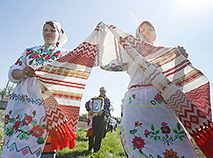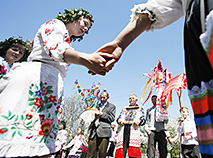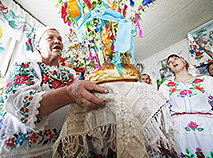Spring Rite of Jurauski Karahod
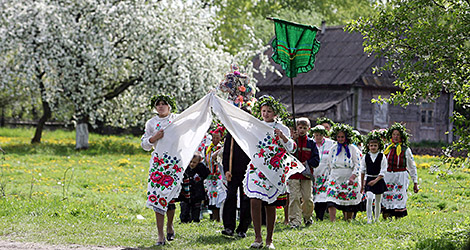
The beautiful folk rite Jurauski Karahod has survived to this day and is performed only in one village in the Belarusian Polesie. Tourists from all over the country and abroad come to see the ancient tradition every year.
In December 2019, it was included in the UNESCO List of Intangible Cultural Heritage in Need of Urgent Safeguarding. The decision to give the item from Belarus the status of the value of international importance, which needs special safeguarding, was approved at the 14th session of the UNESCO Intergovernmental Committee for the Safeguarding of the Intangible Cultural Heritage in Bogota, Colombia. The village of Pahost will, of course, continue to perform the rite passing it on to new generations and showing it to the world.
Did you know that…
The first Belarusian item to be included in the UNESCO List of Intangible Cultural Heritage in Need of Urgent Safeguarding in 2009 was a unique winter carnival ceremony Kalyady Tsars (Christmas Tsars). Every year on the Generous Evening from 13 to 14 January, the young men of the village of Semezhava (Kopyl District, Minsk Oblast) dress up as brave warriors, put up a cheerful performance with jokes and wish-making, and after the sunset arrange a torchlight procession.
The country's largest festival of pilgrims – the Budslau Fest (Myadel District, Minsk Oblast) was added to the UNESCO Representative List of the Intangible Cultural Heritage of Humanity in 2018. It was founded in honor of the Budslau Icon of Our Lady.
Saint George’s Day in Pahost village: unique round dance inscribed on UNESCO list
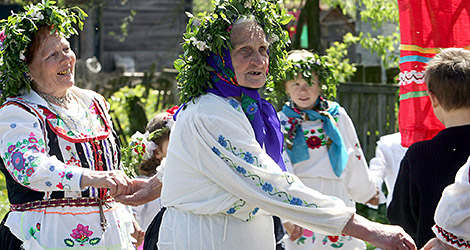
Many Slavic peoples have been celebrating Saint George’s Day since ancient times. It marks the first day animals are put to graze in a pasture after winter. It is the day when peasants inspect their winter crops and start ploughing their fields. On this day people wish each other good cattle and crop yield for the year to come. Each nation has their own nationwide traditions and rare unusual rituals with a local flair. The Jurauski Karahod (Yuriev Round Dance) originating from Polesie is one of such local rites.
In ancient times the rite was observed across various villages not far from Turov, one of Belarus’ oldest towns. However, these days it is observed only in the village of Pahost (Zhitkovichi District, Gomel Oblast). The village is nestled in a picturesque nook of Polesie lowland where the Stviga River flows into the Pripyat River.
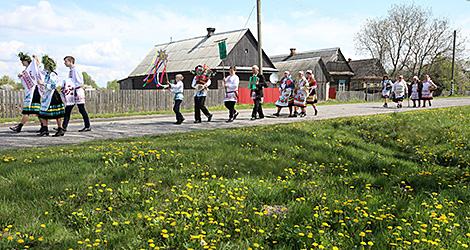
It is worth mentioning that in 2020 Pahost marks its 500th anniversary. The village was first mentioned in chronicles in 1520 when landowner Konstanty Ostrogski donated this settlement to the Turov Assumption Cathedral. In essence, the village is even older than that.
Local residents have preserved dozens of ancient rites and rituals that are marked by the entire community – Christmas and Shchodryk (Generous Evening), Candlemas, Saraki (40 Martyrs of Sabaste), and Gukanne Vyasny (Spring Calling), Kupalle, as well as family feasts (birthday, baptism, matchmaking and wedding), the famous talaka, and naturally the Jurauski Karahod!
The main keeper of the rites of the Pahost village is Katsiaryna Panchenya. The old woman knows local traditions inside and out, she sings hundreds of ritualistic songs and has an extensive collection of local arts and crafts at home. The rooms are decorated with self-made blankets and carpets, curtains, tablecloths and towels embroidered with Polesie patterns. It is here where the locals often gather to prepare for the rite.
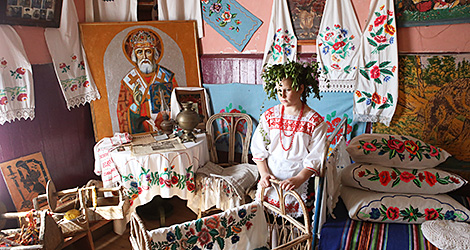
About 40 years ago Katsiaryna Panchenya revived the Jurauski Karahod rite. Since her childhood she, together with her parents and fellow villagers, has taken part in the ceremony. The rite was performed even during the difficult years of the Great Patriotic War. Later, however, the tradition was forgotten for some time in the village.
After its revival, the famous rite is held every year, gathering locals and visitors on 6 May, St. George’s Day (St. Yuri Day), a patron of livestock and agriculture (23 April by the Julian calendar). Tourists, journalists, and ethnographers come to see the performance.
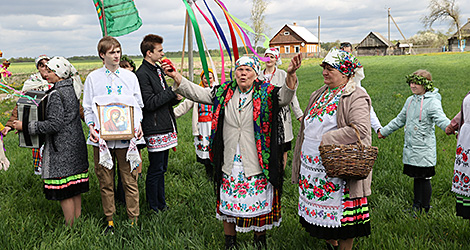
The preparations for the rite are made in advance. On its eve, villagers clean up their houses and courtyards, weave wreaths, and, what is most importantly, bake the ceremonial bread called "Karahod". Women bake the bread together, decorating it with symbols of the harvest, wheat heads made of dough. They also bake buns in the shape of birds, heralds of spring. Another important element of the rite is "raltsa", symbolizing the woman: three branches of a fruit tree are wrapped in pastry and baked in the oven, together with the Karahod. The villagers decorate the ceremonial bread with handmade flowers made of bright paper ribbons and live blooming branches of garden trees.
On the day of the rite, the inhabitants of Pahost dress up as in the old days and go to the field in a large procession, passing through the symbolic "gate of towels" on their way. The venerated icon of the Mother of God is at the head of the procession. It if followed by the "commander" with the ceremonial "round dance" bread. Next come the eight-pointed star and the green apron fastened to a wooden rake. All these symbols are entrusted only to men.
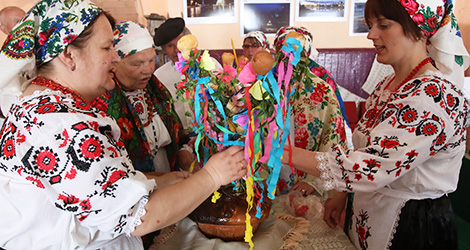
In the field, a priest says a prayer and sprinkles the ground with holy water as villagers call on St. George to "get up early, wash [himself] clean, saddle a horse, and go unlock the earth and let out the dew". Asking for a good harvest, they bury a crust of sacrificial black bread baked from last year’s flour: the crust is tied with a symbolic red ribbon for a good harvest.
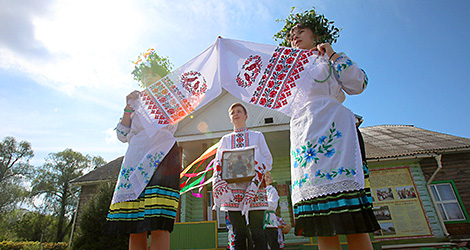
This is where a true celebration begins: everyone does a round dance clockwise around the symbols of the rite, singing ancient spring-calling songs. The bread is held up to the sky three times, and the green apron is switched to a red one. After that the procession returns back to the village. The participants stop by some households to do a round dance. Villagers thank them for wishes of health and well-being with treats.
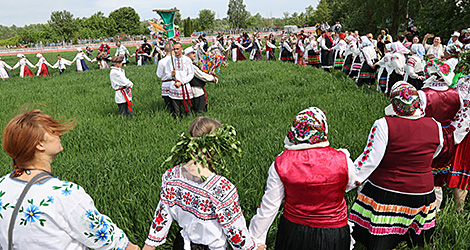
The unique tradition of Jurauski Karahod that is carefully safeguarded by Pahost residents, was inscribed on the UNESCO List of Intangible Cultural Heritage in Need of Urgent Safeguarding. By the way, this was the first rite to be added to the Belarusian national historical and cultural heritage list. Intangible heritage has been included in the list since 2004, when Belarus signed the UNESCO Convention for the Safeguarding of the Intangible Cultural Heritage adopted in 2003.







 print version
print version make home page
make home page add to bookmarks
add to bookmarks